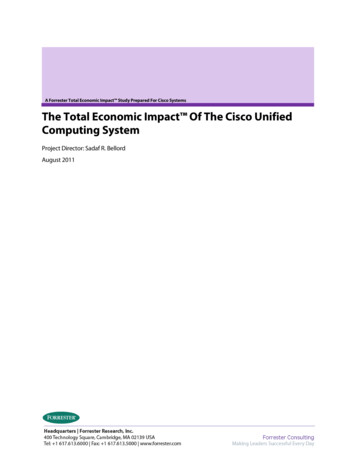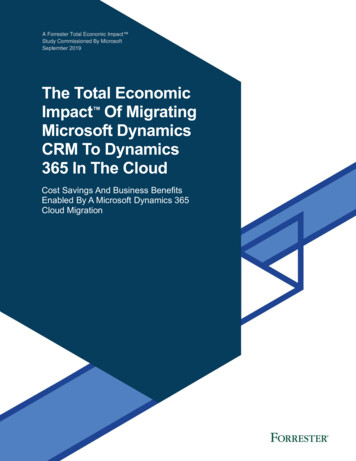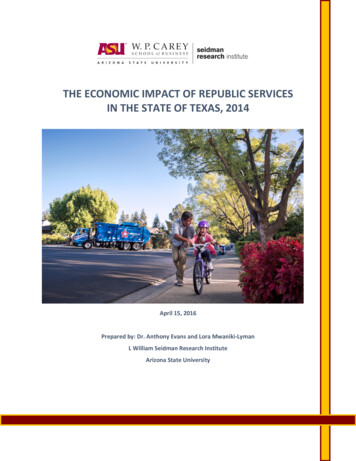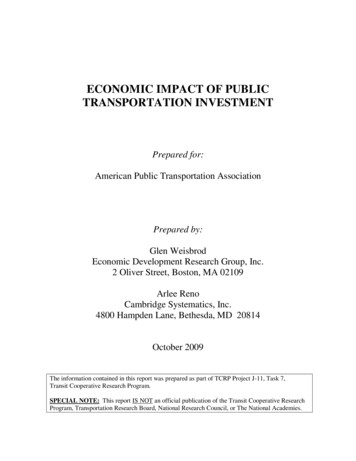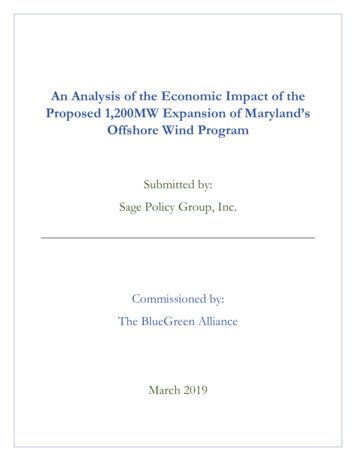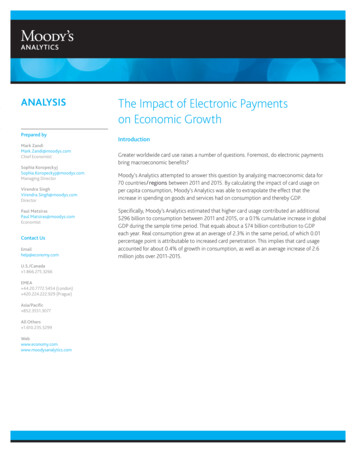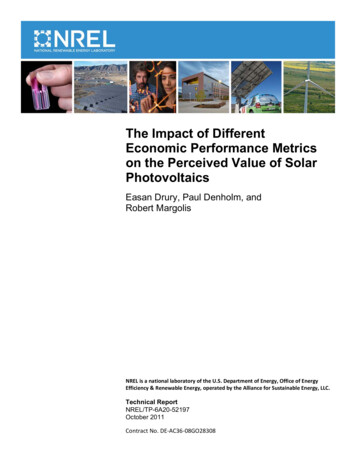
Transcription
The Impact of DifferentEconomic Performance Metricson the Perceived Value of SolarPhotovoltaicsEasan Drury, Paul Denholm, andRobert MargolisNREL is a national laboratory of the U.S. Department of Energy, Office of EnergyEfficiency & Renewable Energy, operated by the Alliance for Sustainable Energy, LLC.Technical ReportNREL/TP-6A20-52197October 2011Contract No. DE-AC36-08GO28308
The Impact of DifferentEconomic Performance Metricson the Perceived Value of SolarPhotovoltaicsEasan Drury, Paul Denholm, andRobert MargolisPrepared under Task No. SS10.2210NREL is a national laboratory of the U.S. Department of Energy, Office of EnergyEfficiency & Renewable Energy, operated by the Alliance for Sustainable Energy, LLC.National Renewable Energy Laboratory1617 Cole BoulevardGolden, Colorado 80401303-275-3000 www.nrel.govTechnical ReportNREL/TP-6A20-52197October 2011Contract No. DE-AC36-08GO28308
NOTICEThis report was prepared as an account of work sponsored by an agency of the United States government.Neither the United States government nor any agency thereof, nor any of their employees, makes any warranty,express or implied, or assumes any legal liability or responsibility for the accuracy, completeness, or usefulness ofany information, apparatus, product, or process disclosed, or represents that its use would not infringe privatelyowned rights. Reference herein to any specific commercial product, process, or service by trade name,trademark, manufacturer, or otherwise does not necessarily constitute or imply its endorsement, recommendation,or favoring by the United States government or any agency thereof. The views and opinions of authorsexpressed herein do not necessarily state or reflect those of the United States government or any agency thereof.Available electronically at http://www.osti.gov/bridgeAvailable for a processing fee to U.S. Department of Energyand its contractors, in paper, from:U.S. Department of EnergyOffice of Scientific and Technical InformationP.O. Box 62Oak Ridge, TN 37831-0062phone: 865.576.8401fax: 865.576.5728email: mailto:reports@adonis.osti.govAvailable for sale to the public, in paper, from:U.S. Department of CommerceNational Technical Information Service5285 Port Royal RoadSpringfield, VA 22161phone: 800.553.6847fax: 703.605.6900email: orders@ntis.fedworld.govonline ordering: http://www.ntis.gov/help/ordermethods.aspxCover Photos: (left to right) PIX 16416, PIX 17423, PIX 16560, PIX 17613, PIX 17436, PIX 17721Printed on paper containing at least 50% wastepaper, including 10% post consumer waste.
AcknowledgmentsThis work was funded by the U.S. Department of Energy’s (DOE’s) Office of Energy Efficiencyand Renewable Energy (EERE). We thank Justin Baca, Solar Energy Industry Association(SEIA), and David Feldman (NREL) for their thoughtful review of this report. We also thankDouglas Arent, Joint Institute for Strategic Energy Analysis (JISEA), Michael Mendelsohn(NREL), Colin Murchie (SolarCity, Inc.), and Paul Schwabe (NREL) for comments and input.We thank Jarett Zuboy for help in drafting the report and Mary Lukkonen (NREL) for editorialsupport.iii
List of AcronymsACB/C IPPAPVRECSRECTNPWalternating currentbenefit-to-cost ratiocarbon dioxideconsumer price indexdirect currentgross domestic productinvestment tax creditinternal rate of returnkilowattkilowatt-hourlevelized cost of energymodified accelerated cost recovery systemmonthly bill savingsmodified internal rate of returnnet present valueoperations and maintenanceprofitability indexpower purchase agreementphotovoltaicsrenewable energy certificatesolar renewable energy certificatetime-to-net-positive-cash-flowwattiv
Executive SummaryPhotovoltaic (PV) systems are installed by several types of market participants, ranging fromresidential customers to large-scale project developers and utilities. Each type of marketparticipant frequently uses a different economic performance metric to characterize PV valuebecause they are looking for different types of returns from a PV investment. We find thatdifferent economic performance metrics frequently show different price thresholds for when aPV investment becomes profitable or attractive. Additionally, several project parameters, such asfinancing terms, can have a significant impact on some metrics [e.g., internal rate of return(IRR), net present value (NPV), and benefit-to-cost (B/C) ratio] while having a minimal impacton other metrics (e.g., simple payback time). As such, we find that the choice of economicperformance metric by different customer types can significantly shape each customer’sperception of PV investment value and ultimately their adoption decision.In this analysis, we characterize PV economic performance for three ownership types: residentialcustomers who purchase their own PV systems, commercial customers (for-profit companies)who purchase their own PV systems, and residential and commercial customers who lease PVequipment or buy PV electricity from a third-party company. We characterize the differences inPV economics for each customer based on the different tax implications of ownership. We do notcharacterize PV economics for large-scale PV developers or utilities because they frequently usecomplex project financing structures (Harper et al. 2007) that are beyond the scope of thisanalysis.We compare PV economic returns for different PV customers using the following economicperformance metrics: Net present value (NPV) Profitability index (PI) Benefit-to-cost (B/C) ratio Internal rate of return (IRR) Modified internal rate of return (MIRR) Simple payback and time-to-net-positive-cash-flow (TNP) payback Annualized monthly bill savings (MBS) Levelized cost of energy (LCOE).We characterize relative PV economics for each metric over a range of system characteristics,including PV system price and several non-price parameters including financing terms, tax rates,electricity rates and assumed rate escalations, and PV system performance. Key findings include: Different economic performance metrics can show unique price thresholds for when aPV investment becomes profitable or attractive.v
In some cases, the choice of an economic performance metric could have as muchimpact on the representation of value as decreasing (or increasing) PV prices by up toa factor of four. Varying non-price system characteristics, such as financing terms or assumedelectricity rate increases, can impact PV economic performance as much asdecreasing (or increasing) PV prices by several dollars per watt. At higher PV prices, commercial projects may generate higher returns than residentialprojects because commercial customers can depreciate the capital invested in a PVproject. At lower PV prices, commercial projects may generate lower returns becausethe gain from capital depreciation is offset by the loss from valuing PV based on taxdeductible energy costs. IRR is a poor metric for characterizing the value of U.S. PV systems because theupfront nature of financed PV costs and incentives can lead to an inflated perceptionof value. MIRR and simple payback times show very little sensitivity varying several projectparameters, and customers using these metrics may be less likely to be incentivizedby policy measures targeting non-price system parameters. The MBS metric may generate attractive returns at higher PV prices than othermetrics and may be effective at stimulating PV markets. However, the third-party PVcompanies that frequently market systems based on MBS have different tax structuresand costs of capital, and it is unclear whether this will lead to higher or lower relativereturns. The upfront nature of U.S. PV incentives (e.g., federal investment tax credit andaccelerated capital depreciation for commercial customers) can lead to very differentPV returns for U.S. systems relative to identical systems located in different countriesthat are described in the international PV literature.The different price thresholds for when a PV investment becomes profitable or attractive and thedifferent sensitivities to varying system parameters have significant implications for policydesign. For example, if policy is introduced to improve PV financing terms, it couldpreferentially stimulate market segments where customers use metrics that are sensitive tofinancing terms (IRR, NPV, and B/C ratios) while having little or no impact on market segmentswhere customers use metrics that are insensitive to financing terms (simple payback). There isalso a strong potential for stimulating U.S. PV demand using new mechanisms in addition totraditional incentives focused on reducing PV prices or increasing revenues. These range fromsimply educating potential customers about the value of a PV investment as seen throughdifferent economic performance metrics, to providing access to long-term low-cost financing, toallowing third-party companies to develop simple PV products that can generate MBS.vi
Table of ContentsList of Figures . viiiList of Tables . viii1Introduction . 12Types of PV Adopters and Markets . 23Parameters that Influence PV Economic Performance . 343.1 PV Prices.33.2 Non-Price System Parameters.33.3 Business Models .4Metrics Commonly Used to Represent PV Economic Performance . 64.1 Net Present Value .84.2 Profitability Index and Benefit-to-Cost Ratio .84.3 Internal Rate of Return and Modified Internal Rate of Return .94.4 Simple and Time-to-Net-Positive-Cash-Flow Payback .94.5 Annualized Monthly Bill Savings.94.6 Levelized Cost of Energy.104.7 Use of Different Economic Metrics in the PV Literature .105Reference PV System Assumptions . 126Sensitivity Analysis—Effects of PV Price . 177Sensitivity Analysis—Effects of Non-Price Parameters . 218Results Across Performance Metrics . 329Policy Implications . 357.1 Profitability Index and Benefit-to-Cost Ratio .217.2 Internal Rate of Return and Modified Internal Rate of Return .247.3 Simple and Time-to-Net-Positive-Cash-Flow Payback .267.4 Annualized Monthly Bill Savings.287.5 Levelized Cost of Energy.3010 Conclusions and Future Work . 36References . 37Appendix A. Tax Implications for Third-Party PV Ownership . 40Appendix B. The Challenge of Interpreting Internal Rates of Return for U.S. PV Systems . 42vii
List of FiguresFigure 1. Reference residential (a) and commercial (b) undiscounted annual PV system costs,revenues, and tax benefits given in real dollars . 15Figure 2. PV economic performance, characterized using several metrics, for a range of effectivePV prices for residential (“Res”) and commercial (“Com”) systems . 18Figure 3. B/C ratios and the shifted PI (1 PI) are shown for 4,000/kW residential andcommercial PV systems over a range of financing, performance, and marketparameters . 22Figure 4. IRR and MIRR for 4,000/kW residential and commercial PV systems over a range offinancing, performance, and market parameters . 24Figure 5. Simple and TNP payback times for 4,000/kW residential and commercial PV systemsover a range of financing, performance, and market parameters .
on the Perceived Value of Solar Photovoltaics Easan Drury, Paul Denholm, and Robert Margolis. Technical Report NREL/TP-6A20-52197 . October2011 . NREL is a national laboratory of the U.S. Department of Energy, Office of Energy Efficiency & Renewable Energy, operated by the Alliance for Sustainable Energy, LLC. National Renewable Energy Laboratory 1617 Cole Boulevard Golden,
